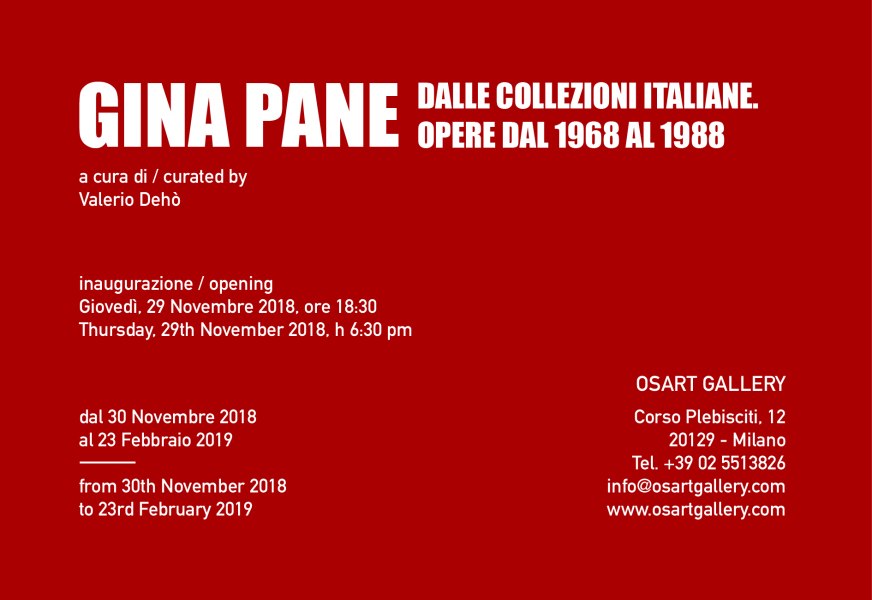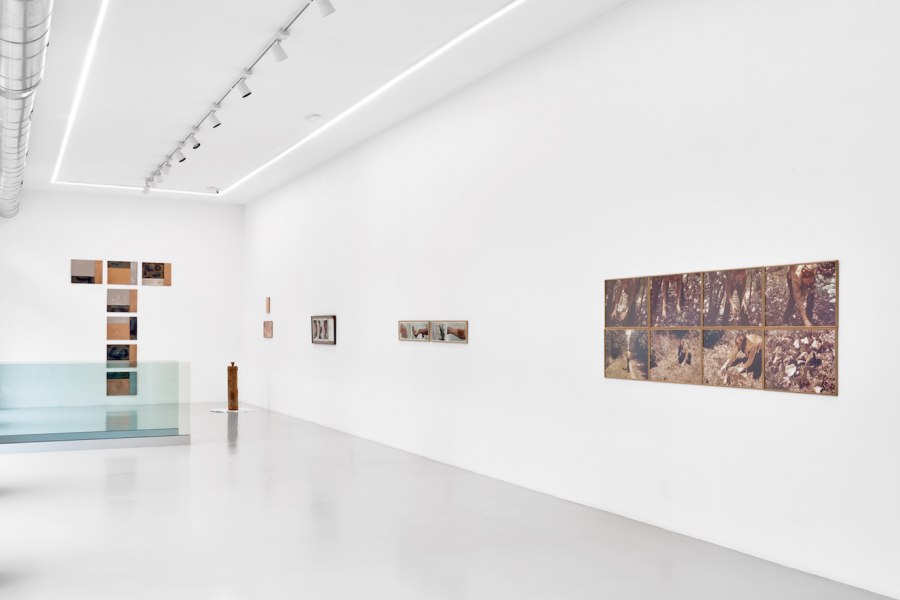GINA PANE DALLE COLLEZIONI ITALIANE. Opere dal 1968 al 1988
A cura di
Partecipa
Fino a
GINA PANE DALLE COLLEZIONI ITALIANE. Opere dal 1968 al 1988
Comunicato
GINA PANE DALLE COLLEZIONI ITALIANE. Opere dal 1968 al 1988
Dal 30 Novembre 2018 al 23 Febbraio 2019 | Osart Gallery, Milano
Opening: Giovedì, 29 Novembre 2018 alle ore 18,30
Gina Pane (Biarritz, 1939 – Parigi, 1990), riconosciuta come una delle maggiori esponenti dellaBody Art,è la protagonista della mostra in programma presso Osart Gallery dal29 novembre 2018al 23 Febbraio 2019. La retrospettiva, a cura di Valerio Dehò,si propone di raccontare la poetica dell'artista italo-francese attraverso una selezione di opere, prodotte tra il 1968 e il 1988, provenienti da importanti collezioni italiane. L'esposizione si compone di “constatazioni”,ovvero sequenze fotografiche che documentano alcune tra le Azioni più celebri di Gina Pane, e di“Partizioni”, ovvero installazionia parete che spesso recano anche parzialmente tracce di opere precedenti delle stesse Azioni.Queste furono presentate a Milano per la prima volta al PAC nel 1985 con la mostra “Partizioni Opere multimedia” a cura di Lea Vergine.
La mostra segue un percorso cronologico e si apre con Pierres déplacées [Pietre spostate] (1968):unasequenza fotografica a colori realizzata nella Valle dell'Orco in provincia di Torino, luogo caro all'artista, nella quale raccoglie pietre di piccola taglia dalle caratteristiche ben precise (“esposte a nord, ricoperte di muschio, incastrate dentro una terra umida”) per spostarle in un luogo orientato verso sud. Quest'opera testimonia una delle prime azioni dove l'artista supera la fase d'esordio delle sculture minimaliste (chiamate “Structures affirmées”)e si interroga sul rapporto uomo-natura. La stessa celebre serie di fotografie “Alpi marittime” di Giuseppe Penone è degli stessi anni e sempre in Piemonte.
Si passa dunque alla celebre Azione Sentimentale,tenutasi alla Galleria Diagramma di Milano nel 1973. L'azione originale, divisa in quattro fasi, è dedicata alle donne alle quali fu chiesto di disporsi in cerchi tracciati a terra con il gessetto all'interno dei quali figurava la parola DONNA. L'artista è vestita di bianco e porta un bouquet di rose rosse dalle quali stacca tutte le spine conficcandole poi nel suo stesso braccio. Le toglie lasciando colare un rivolo di sangue. Le rose rosse del bouquet diventano bianche. Il vestito bianco si tinge di rosso.
Sempre dei primi anni Settanta troviamo Action mélancolique2x2x2, 1974 eAction Psyché (Essai), 1974-1975.
InAction mélancolique 2x2x2 [Azione Malinconica 2x2x2]la malinconia viene esplorata evocando la relazione di coppia in tutte le combinazioni possibili. La ferita che compare nell'opera è stata praticata dall'artista all'altezza dell'orecchio e allude al famosogesto disperato di Vincent Van Gogh. Qui, l'altro fa la sua comparsa e a fianco dell “io”rappresentato da Gina Pane compare il “tu”rappresentato dalla schiena nuda di una ragazza. Il cuore disegnato, quindi, inscrive la relazione amorosa in uno spazio non più codificato dal genere ma dalla forza assoluta del sentimento. “L'Azione”, dice l'artista, “permette agli altri di prendere coscienza del conflitto e di passare da una situazione isolata ad una situazione unificatrice”.
L'Action Psyché (Essai) [Azione Psiche (Prova)]qui esposta condensa attraverso tre scatti fotografici le fasi più strazianti dell'azione. Sul viso di Gina Pane, che ha gli occhi chiusi, colano lacrime di sangue dalle palpebre che ha tagliato in precedenza con una lama di rasoio. “Quattro linee partono dal centro del corpo: l'ombelico 'IO' è il centro che si propaga nelle quattro direzioni riportando all'unità I punti estremi in una sintesi di amore”. La bellezza ideologica e plastica dell'Action Psyché descrive al meglio la filosofia pittorica del linguaggio di Gina Pane che in questo modo spinge oltre il linguaggio privilegiato della Body Art.
E se la psiche è il fulcro dell'organismo,nell'operaIo mescolo tutto: Cocaina, Frà Angelico,Gina Pane utilizza il corpo come strumento naturale di essa. L'azione eseguita il 30 ottobre 1976 è la prima in un museo, la Galleria Comunale d'Arte Moderna di Bologna. Mentre due giovani si rilanciano una pallina su un tavolo appoggiato al muro, l'artista servendosi di una scheggia di un vetro andato in frantumi si incide sull'avambraccio il disegno di alcuni pezzi di un gioco trovati per terra. La rottura del vetro, materiale importante per l'artista, in diverse opere rappresenta la modalità di uscire da una cornice "per andare in strada, nel mondo, non a livello dei manichini ma a livello della carne”.
Dal 1981 Gina Pane termina il ciclo delle Azionied inizia quello delle Partizioni.L'artista abbandona per limiti fisici l'uso del proprio corpo come linguaggio e ritorna alla scultura con l'esperienza performativa alle spalle. Ne L'Homme à la branche verte qui n'avait pas lu les Fleurs du mal – Partition pour une blessure[L'uomo con il ramo verde che non aveva letto i Fiori del Male – Partizione per una ferita], 1982. Gina Pane torna sull'idea di ferita con una foto che ricorda l'Action Sentimentale e che occupa un posto centrale dell'installazione.Per l'artista la ferita simboleggia la vita piuttosto che la morte; il sangue rappresenta un’offerta di amore verso il prossimo oltre ad essere una fonte di energia che libera l'uomo dai propri limiti. Chi la disprezza è ritenuto ridicolo, esattamente come l'uomo raffigurato con il rametto verde che non aveva letto Baudelaire. Il ciclo si chiude con Le Son de F. L'homme indien en prière (version 3)[Il suono di F. L'uomo indiano in preghiera (versione 3)],1986-88.Quest'opera della seconda metà degli anni Ottanta si compone di più pannelli assemblati. I materiali di cui si compone l'opera sono principalmente rame e ferro, materiali su cui l'artista interviene. “come se lavorassi con il mio corpo di carne ed ossa, nervi, muscoli, sangue”, sottolinea Gina Pane, infatti “il rame è un materiale vivo non appena lo toccate appaiono delle tracce”. La geometria di tali pannelli ricorda i polittici posti dietro o sopra gli altari delle chiese medioevali, mentre la disposizione a “T” evoca nuovamente la forma della croce. Nel titolo si fa riferimento a San Francesco una delle figure centrali delle Partitionsdi Gina Pane alla cui vita l'artista dedica diverse opere, affascinata dalla povertà del santo di Assisi e dalla sua visione della fede come dura disciplina.
Note biografiche (1939-1990)
Gina Pane nasce a Biarritz, Francia, il 24 maggio del 1939 da padre italiano e madre austriaca. Trascorre la sua infanzia a Torino e si trasferisce a Parigi nel 1961 per frequentare la Scuola Nazionale di Belle Arti. Inizialmente realizza dipinti di natura astratta geometrica che trasferisce poi nello spazio attraverso la scultura: il risultato sono opere monumentali che interagiscono con gli spettatori, idea importante per la sua futura ricerca artistica. Nel 1970 Gina Pane realizza le prime Azioni che diverranno il suo marchio di fabbrica rendendola la maggiore figura nella storia internazionale della Body Art. Nel 1985 abbandona le Azioni per dedicarsi alle Partizioni, installazioni che permettono di trasferire sulla materia le evocazioni di un corpo ormai assente, come quello dei santi e dei martiri a cui l'artista dedica molte delle sue opere. Gina Pane si spegne il 6 marzo del 1990 a causa di una lunga malattia.
-------------------------------
(English version)
GINA PANE FROM THE ITALIAN COLLECTIONS. Works from 1968 to 1988
From 30 November 2018 to 23 February 2019 | Osart Gallery, Milan
Opening: Thursday, 29 November 2018 at 6:30 p.m.
Gina Pane(Biarritz, 1939 – Paris, 1990),renowned as one of the leading exponents of Body Art,is the protagonist of the exhibition scheduled to run at the Osart gallery from 29 November 2018to 23 February 2019. The retrospective,curated by Valerio Dehò,aims to narrate the poetics of the Italian-French artist through a selection of works produced between 1968 and 1988, originating from important Italian collections. The exhibition consists ofObservations(constatazioni)– photographic sequences documenting some of Gina Pane’s most famous Actions– and Partitions, installations, frequently wall-hung, that also bear partial traces of the earlier Actions. These were presented for the first time at the PAC in Milan in 1985, in the show “Partitions Opere Multimedia” curated by Lea Vergine.
The exhibition is organised chronologically and opens with Pierres déplacées[Displaced Stones],1968:aphotographic sequence in colour produced in the Valle dell'Orco in the province of Turin, a place the artist was very fond of. Here she collected small stones with very precise characteristics (“with a northern exposure, covered in moss and set within moist soil”) and then moved them to a southward-facing location. This work illustrates one of the first actions in which the artist goes beyond the initial phase in which she created minimalist sculptures (calledStructures affirmées, or Affirmed Structures)to ponder the relation between man and nature. The famous Alpi marittime(Maritime Alps) series of photos by Giuseppe Penone, again located in Piedmont, dates to the same period.
Then we find the famous performance Azione Sentimentale[Sentimental Action], at the Galleria Diagramma of Milan in 1973. The original action, divided into four phases, was addressed to a female audience. The women were invited to arrange themselves around circles traced on the ground with chalk, in the centre of which was the word “Donna” (Woman). The artist, dressed in white, carried a bunch of red roses, from which she removed the thorns, proceeding to stick them into her own arms. She then removed the thorns, letting the rivulets of blood trickle forth. The red roses of the bouquet became white, and the white dress was stained with red.
Also dating to the early 1970s were Action mélancolique2x2x2, 1974andAction Psyché(Essai),1974-1975.
InAction mélancolique2x2x2[Melancholic Action 2x2x2]melancholy is explored by evoking the relationships of couples in all possible combinations. The wound that appears in the performance was made by the artist close to the ear, alluding to the famous gesture ofVincent Van Gogh. Here, the Other makes its appearance, and alongside the “I” represented by Gina Pane there appears the “you” represented by the naked back of a girl. The heart drawn upon it, therefore, sets the amorous relationship in a space no longer codified by gender but by the absolute force of the sentiment. As the artist explains, “The Action allows others to become aware of the conflict and to pass from an isolated situation to a unifying one.”
TheAction Psyché(Essai)[Psyche Action (Essay)] displayed here condenses the most agonising phases of the action in three photos. In one, Gina Pane is shown with her eyes closed as tears of blood fall from the eyelids that she previously slit with a razor blade. Another is described by the artist herself: “Four lines start from the centre of the body: the navel “I” is the centre that extends outwards in four directions unifying the furthermost points in a synthesis of love.” The ideological and plastic beauty of Action Psyché offers a perfect description of the pictorial philosophy of Gina Pane’s language, who thus goes beyond the preferential language of Body Art.
And if the psyche is the fulcrum of the organism, in the work Io mescolo tutto: Cocaina, Frà Angelico[I mix everything: Cocaina, Frà Angelico], Gina Pane uses the body as the psyche’s natural instrument. This action was performed on 30 October 1976 and was the first in a museum: the Galleria Comunale d'Arte Moderna in Bologna. While two youngsters throw a ping pong ball to each other along a table set against a wall, the artist takes a splinter from a shattered pane of glass and uses it to draw on her forearm the outline of some pieces of a game found on the ground. In several works the shattering of glass – which is an important material for the artist – represents a way of getting out of the frame “going out into the street, into the world, not as mannequins but as flesh and blood.”
From 1981 on Gina Pane ended the cycle of the Actionsand began that of the Partitions. For motives of physical limitation, the artist abandons the use of her own body as language and returns to sculpture with the performative action behind her. In L'Homme à la branche verte qui n'avait pas lu les Fleurs du mal – Partition pour une blessure[The man with the green branch who had not read Les Fleurs du Mal – Partition for a wound], 1982, Gina Pane returns to the idea of the wound with a photo that recalls Action Sentimentale and occupies a central position in the installation.For the artist, the wound symbolises life rather than death; the blood represents an offering of love to one’s neighbour, a fount of energy that frees man from his limitations. Those who despise it are considered ridiculous, exactly like the man shown with the green branch who had not read Baudelaire. The cycle closes with Le Son de F. L'homme indien en prière (version 3)[The sound of F. The Indian man at prayer (version 3)], 1986-88. This work, dating to the second half of the 1980s, is made up of several panels, assembled mostly from copper and iron, on which the artist intervenes. As Gina Pane stresses: “it is as if I were working with my own body made of flesh and bone, nerves, muscles and blood.” Indeed, “copper is a live material, as soon as you touch it you can see the traces.” The geometry of these panels recalls the polyptychs positioned above or behind the altars in the mediaeval churches, while the T-shaped layout also evokes the shape of the cross. The title refers to Saint Francis, one of the central figures in Gina Pane’s Partitions. She devoted several works to the saint from Assisi, fascinated by his poverty and by his vision of faith as harsh discipline.
Biographical notes (1939-1990)
Gina Pane was born in Biarritz, France, on 24 May 1939 to an Italian father and an Austrian mother. She spent her childhood in Turin and moved to Paris in 1961 to attend the Ecole des Beaux-Arts. She started her artistic career creating paintings of geometric abstraction, which she then transferred to space through sculpture. The result was monumental works that interacted with the observer, which was an important concept in her later artistic research. In 1970 Gina Pane produced the first Actions, which then became her hallmark and made her the leading exponent in the international history of Body Art. In 1985 she abandoned theActionsto devote herself to the Partitions, installations that allowed her to transmit to matter the evocations of a body by then absent, such as those of the saints and martyrs that many of her works addressed. Gina Pane died on 6 March 1990 after a long illness.
Come arrivare
- letto 956 volte




